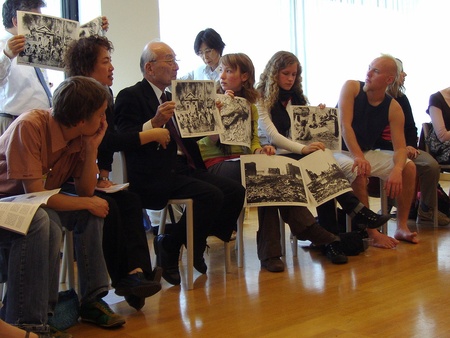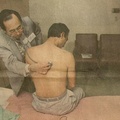Read Part 1 >>
For many years the hibakusha’s psychological and emotional wounds festered in their minds as they lived lives of emotional isolation, but in the 1960s the hibakusha began to unite. With the worsening of atomic-bomb related illnesses such as cancers, the atomic-bomb survivors desire for empathy, and the arrival of “international brides”: Japanese-born hibakusha who had married Americans and immigrated to America along with their American (sometimes Japanese American) spouses, during the 1960s-70s, the American hibakusha began to organize through groups such as the “Hibakusha Friend Group”.
On August 6, 1965, the anniversary of the bombing of Hiroshima, an advertisement was taken out in the Japanese American newspapers The Rafu Shimpō and the Kashū Mainichi with a “Call to All Hiroshima and Nagasaki A-Bomb Survivors”1 showing one of the first instances of the American Hibakusha organizing in public. While “the reason for forming this group was to launch a drinking fellowship of kindred souls,”2 it is still the first notable attempt at forming a group of hibakusha in America. The meeting was scheduled for August 12, 1965, the 20th anniversary of the atomic bombing of Hiroshima but was an utter failure due to the fears of the hibakusha as explained by the leader of a local hibakusha group, “If for any reason their A-bomb experience becomes known, their insurance would be terminated immediately.”3
Despite the underwhelming number of hibakusha willing to reveal themselves or fight for rights they believed they deserved, August 12, 1965, would become a date known for one group’s fortitude; August 12th was the second day of the Watts Riots (which also took part in Los Angeles), a milestone in the African American civil rights movement, which may have either consciously or subconsciously had an effect on these American hibakusha. Despite the failure of the Friends of the Hibakusha group, changes appeared to be taking place within the American hibakusha community; eventually in 1970 the CABS (Committee for A-Bomb Survivors) was formed. It was with this group that the Japanese Americans would finally begin their fight for free healthcare and be recognized by the American government.4 While correlation does not necessarily prove causation, the intensification of the Civil Rights movement coincides quite well with the beginning of the American hibakusha’s fight for healthcare provided by the American government.

Behind this later fight for free healthcare was the American hibakusha’s desire to feel American; they believed that if they were able to receive healthcare from the American government it would not only ease a gargantuan financial burden but also prove their status as Americans, not the “enemy,” as they had long been portrayed.
While the American hibakusha and the American hibakusha activists were struggling to feel American, in 1976 President Ford issued an apology for the internment of the Japanese Americans (later in 1988 a bill was passed repaying about 2 billion dollars worth of damages to those who had been interned) continuing to distance the hibakusha from their Japanese American counterparts.
A few years later in a 1978 exchange between two Japanese American activists, Kanji Kuramoto (previously mentioned) and Harry I. Takagi, and the White House, the desire of the Japanese Americans to be treated as American citizens by the American government is clearly exemplified. Mr. Kuramoto originally wrote a letter to the White House regarding his belief that the American hibakusha deserved free healthcare provided by the U.S. government to which he received a response from the head of Japanese affairs, Mr. Featherstone; however, both he and Mr. Takagi felt the response was insufficient and inconsiderate:
Dear Mr. President:
… Mr. Kuramoto is dissatisfied with Mr. Featherstone’s reply, because (1) Mr. Featherstone showed no recognition of the fact that he was dealing with an American citizen, and (2) Mr. Featherstone’s office appears to be one which deals principally with the affairs of Japanese in Japan, rather than with the rights of American citizens of Japanese ancestry. Mr. Kuramoto is not alone in his feelings; we who are loyal American citizens wish to be so recognized and treated as such, and not confused with citizens of foreign country.5
Mr. Takagi’s letter received no response from the White House, which did nothing to fulfill his yearning to be seen as an American.
Led by the likes of: Kanji Kuramoto (President of the CABS), Dr. Thomas Noguchi (renowned coroner, who performed autopsies on Marilyn Monroe and RFK), Dr. Mitsuo Inouye (then President of the Japanese American Medical Association), as well as other notable activists, the American hibakusha began to openly and passionately fight for free healthcare. In 1971 with news that a team of Japanese doctors, who were familiar with radiation-related diseases, were coming to Los Angeles, many American hibakusha decided to end their silence; soon after, a 1971 Newsweek article came out providing a somewhat accurate narrative of the American hibakusha.6
Shortly thereafter, in 1972 a bill, HR17112, was introduced in the House of Representatives but was quickly rejected. Later, “In 1973 a joint Los Angeles City/County-Hiroshima Atomic Bomb Survivors Clinic was held at L.A. County/U.S.C. Medical Center. In 1974, State Senator (now Lt. Governor Mervyn M. Dymally) chaired a California Legislative hearing into the plight of the survivors,”7 continuing to raise public awareness and, “support calling for assistance for their extended and expensive medical costs.”8 In 1975 a bill titled SB-15, was introduced in front of a subcommittee of the California Senate, and stated:
Any California resident who suffers from atomic radiation as a result of exposure to atomic rays due to any wartime activity, or who was exposed to radiation on the job, or who was exposed to radiation by being in the vicinity of a nuclear radiation accident, or who is the natural child by birth of a parent who was in the vicinity of an atomic bombing or direct vicinity of a nuclear radiation accident, shall be eligible for treatment under Medi-Cal.9
During deliberations a legislator argued, “They were our enemies. Why should we help these people?”10 to which another legislator adamantly responded with, “I have a friend who is an American-born Nisei. Because of the war, he wasn’t able to return to the U.S., but he’s a U.S. citizen.”11 In the end the bill was rejected and, “The public explanation was that the state’s budget was not large enough, and that compensation should be carried out by the federal government,”12 though the belief that the American hibakusha were the enemy surrounded the decision.13
Notes:
1. Sodei, p. 88
2. Sodei, p. 89
3. Interview from Sodei, p. 91
4. Robert Jay Lifton and Greg Mitchell, Hiroshima in America: Fifty Years of Denial (New York: Putnam’s Sons, 1995), 212.
5. Laura Elizabeth Hein and Mark Selden, Living with the Bomb: American and Japanese Cultural Conflicts in the Nuclear Age (Armonk, N.Y.: M.E. Sharpe, 1997), 252.
6. Sodei, p. 101
7. Press release from Dr. Inouye’s collection, p. 2
8. Ibid
9. Primary source document from Sodei, p. 119
10. From interview in Sodei, p. 119
11. Ibid.
12. Sodei, p. 119
13. Ibid.
© 2014 Jordan Helfand




